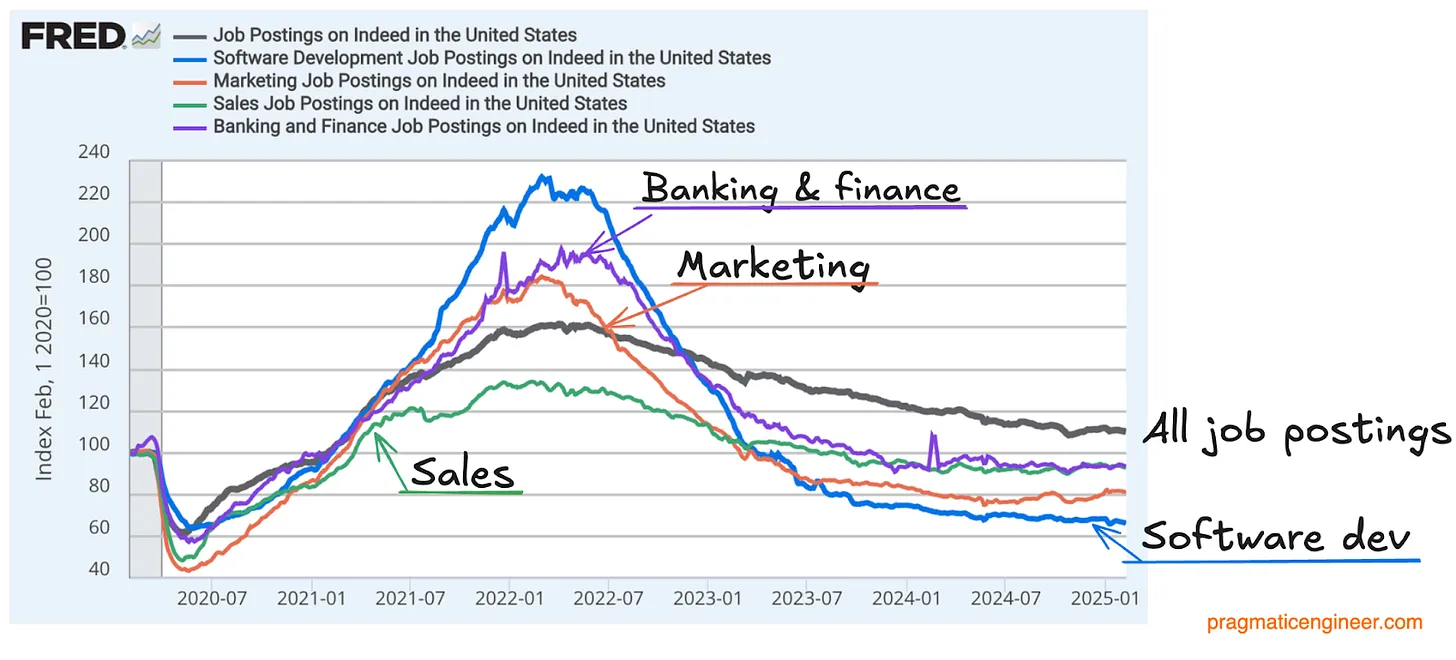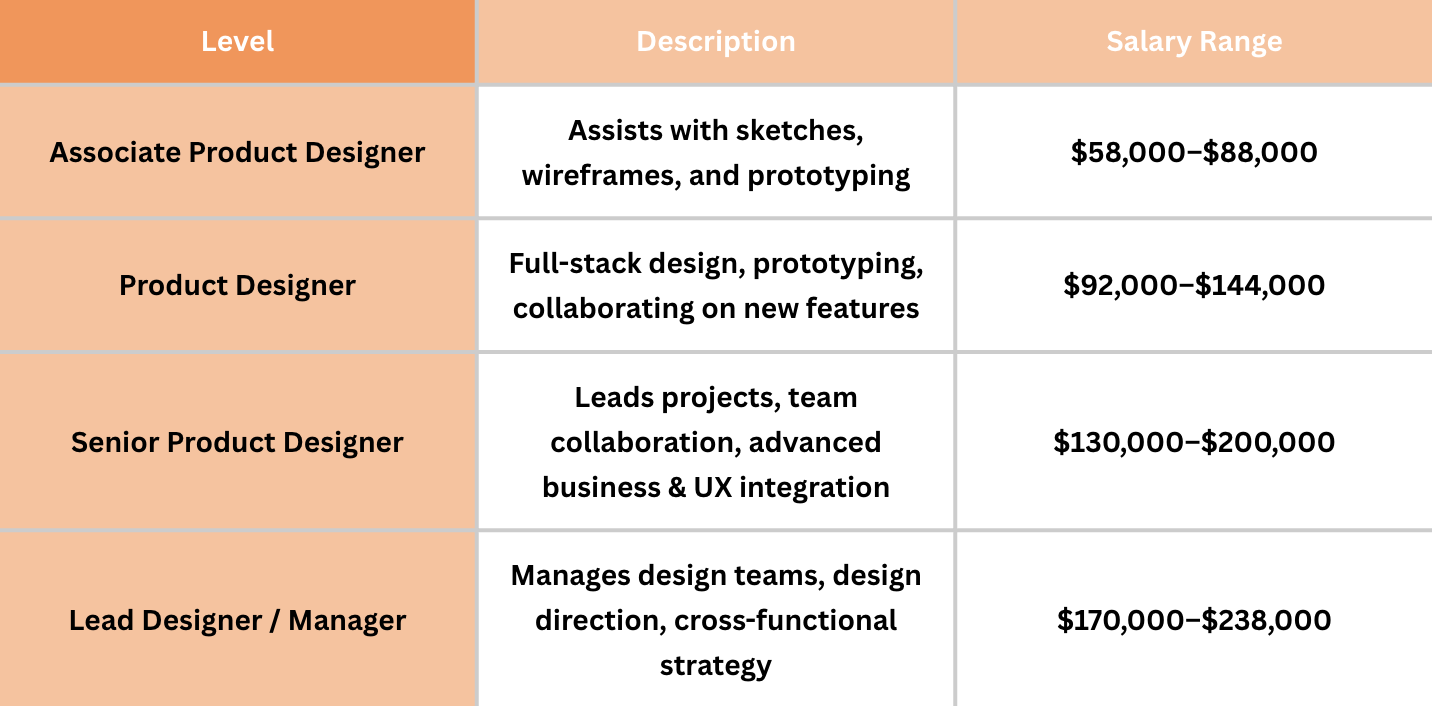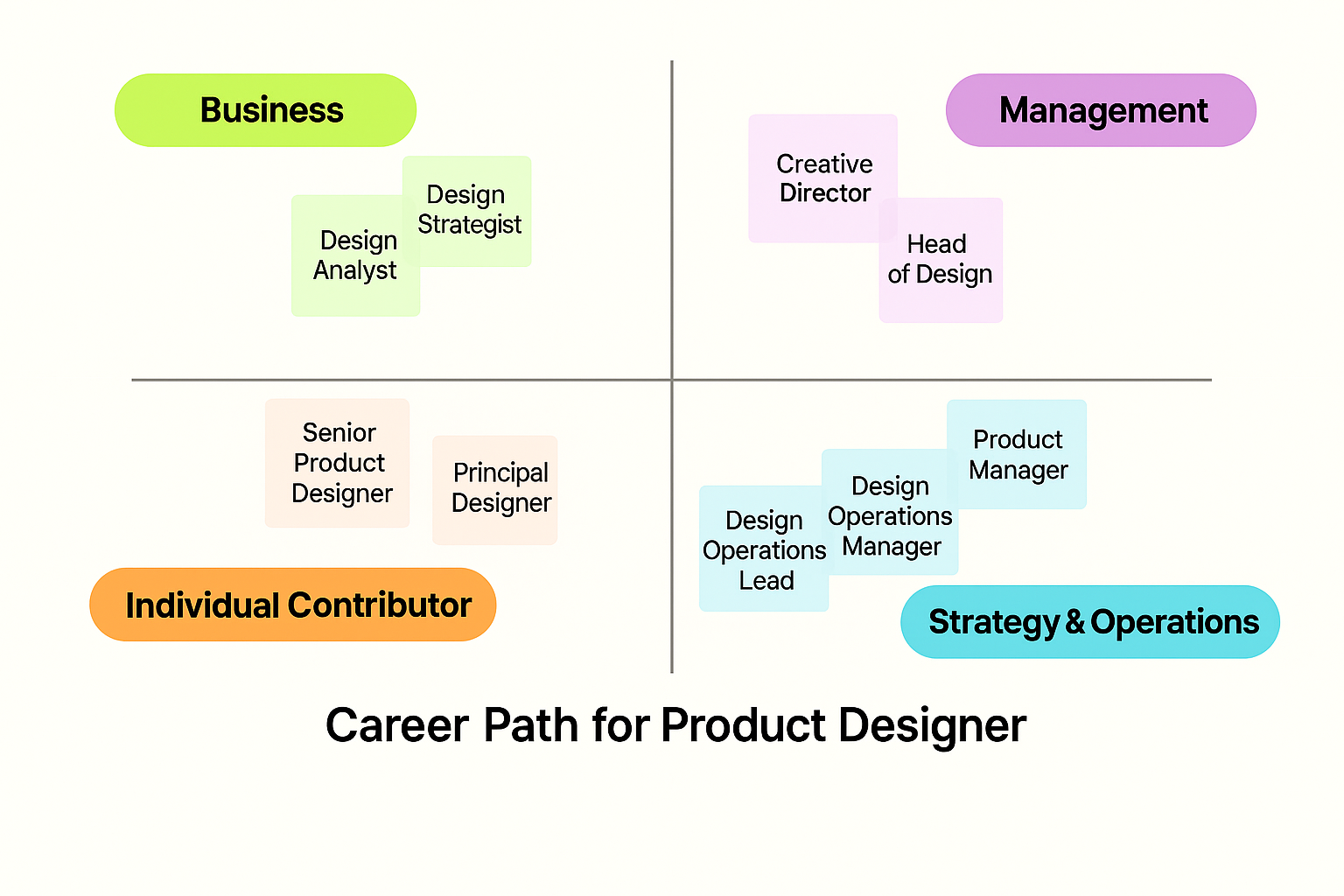Entry Level Job Market Report
Product Design
Overall Rating
Moderate
Competition
Very High
Avg Entry Salary
$90k (USD)
Job Satisfaction
3.5/5
Growth Potential
High
About
Product designers use research, creativity, and digital tools to design, prototype, and improve products that solve user and business problems.
Overall Rating
Moderate
Despite sustained demand in tech, entry-level product design opportunities have declined in recent years, with heightened competition for fewer roles. New hires must show strong portfolios, AI fluency, and proactive collaboration skills to stand out in a transitional, tech-driven landscape.
Competition
Very High
Entry-level product design job openings have drastically decreased in 2024–2025 due to these factors:
AI automation: Many companies use AI to automate parts of design workflows, further reducing entry-level openings. The rise of AI-powered design platforms - such as Figma AI, Adobe Sensei, and automated prototyping tools - has changed the landscape. Routine product design tasks that previously filled an entry-level designer’s workload (asset generation, interface iteration, basic layouts, accessibility checks) are now partially or fully automated. Additionally, non-designers can use these tools to handle basic design updates, further shrinking demand for entry-level product designers and reducing the value proposition of hiring employees without advanced, AI-enhanced skill sets.
Macroeconomic and funding pressures: During the height of the pandemic in 2020–2021, tech and digital product design hiring surged due to explosive demand for digital services, resulting in a flood of job openings and hiring across all seniority levels. However, from late 2022 into 2023, rising inflation, higher interest rates, and economic uncertainty forced many tech companies to halt hiring or enact mass layoffs.
“Job-ready” hiring preferences: Companies prefer choosing designers who are proficient across multiple disciplines (UI, UX, visual, and even some front-end), and who can immediately add value with minimal oversight. Junior candidates - especially new graduates and bootcamp alumni - are now expected to have not just a strong portfolio but fluency in collaboration tools (like Figma), research methods, and increasingly, AI-powered design workflows.
Globalization and outsourcing: Companies are leveraging freelance platforms and outsourcing models to hire qualified designers at a fraction of the domestic cost, or to increase team flexibility in uncertain economic climates. This has made it even more difficult for US-based entry-level candidates to secure jobs, as they’re increasingly competing against a global workforce.
AI automation: Many companies use AI to automate parts of design workflows, further reducing entry-level openings. The rise of AI-powered design platforms - such as Figma AI, Adobe Sensei, and automated prototyping tools - has changed the landscape. Routine product design tasks that previously filled an entry-level designer’s workload (asset generation, interface iteration, basic layouts, accessibility checks) are now partially or fully automated. Additionally, non-designers can use these tools to handle basic design updates, further shrinking demand for entry-level product designers and reducing the value proposition of hiring employees without advanced, AI-enhanced skill sets.
Macroeconomic and funding pressures: During the height of the pandemic in 2020–2021, tech and digital product design hiring surged due to explosive demand for digital services, resulting in a flood of job openings and hiring across all seniority levels. However, from late 2022 into 2023, rising inflation, higher interest rates, and economic uncertainty forced many tech companies to halt hiring or enact mass layoffs.
“Job-ready” hiring preferences: Companies prefer choosing designers who are proficient across multiple disciplines (UI, UX, visual, and even some front-end), and who can immediately add value with minimal oversight. Junior candidates - especially new graduates and bootcamp alumni - are now expected to have not just a strong portfolio but fluency in collaboration tools (like Figma), research methods, and increasingly, AI-powered design workflows.
Globalization and outsourcing: Companies are leveraging freelance platforms and outsourcing models to hire qualified designers at a fraction of the domestic cost, or to increase team flexibility in uncertain economic climates. This has made it even more difficult for US-based entry-level candidates to secure jobs, as they’re increasingly competing against a global workforce.
.png)

-18%
Decrease in product designer jobs between 2020-2025
FRED: Federal Reserve Economic Data

+10%
Change in the overall number of job listings 2020-2025
All jobs: +10%
Banking and finance: -7%
Sales: -8%
Marketing: -19%
Software development: -34%
FRED: Federal Reserve Economic Data
Salary
$90K (USD)
Typical entry-level product designer salaries range from $60,000 to $120,000, with the top 10% earning around $137k. Entry-level salaries are highest in San Francisco, Seattle, and New York (avg: 110k)
Best US Cities for Product Designers (2025): San Francisco, Seattle, Los Angeles, Oakland, Sacramento, Portland, Austin, Boston, New York, Chicago. California and Washington have the most job openings. Texas and Oregon have the most rapid growth in openings.
Top Employers
- Tech giants: Google (Alphabet), Amazon, Microsoft, Apple, Meta
- Other large employers: Wizeline, Paperless Post, Appcues, Yeti, Second Order Effects, Eliassen Group (consulting/staffing), ServiceNow, Siemens, Comcast
Best US Cities for Product Designers (2025): San Francisco, Seattle, Los Angeles, Oakland, Sacramento, Portland, Austin, Boston, New York, Chicago. California and Washington have the most job openings. Texas and Oregon have the most rapid growth in openings.
Top Employers
- Tech giants: Google (Alphabet), Amazon, Microsoft, Apple, Meta
- Other large employers: Wizeline, Paperless Post, Appcues, Yeti, Second Order Effects, Eliassen Group (consulting/staffing), ServiceNow, Siemens, Comcast

Job Satisfaction
3.5/5
Average happiness: 3.5 out of 5 stars. Entry-level product designers report strong creative fulfillment and learning, but frustration over career stagnation, rapidly changing tools, low job security, and market oversupply drag on satisfaction.
Career Potential: Entry-level product designers can eventually pivot into roles like UX/UI lead, product management, design operations, strategy, research, and creative direction - or move into adjacent functions (e.g., user research, business analysis, engineering liaison)
What are potential career paths for product designers?
Career Potential: Entry-level product designers can eventually pivot into roles like UX/UI lead, product management, design operations, strategy, research, and creative direction - or move into adjacent functions (e.g., user research, business analysis, engineering liaison)
What are potential career paths for product designers?

Growth Potential
High
AI isn’t eliminating product designers, but it’s fundamentally reshaping the role:
- AI-powered design tools (e.g., Figma AI, Uizard, DALL·E) rapidly generate wireframes, user flows, and prototypes, automating many routine design tasks and dramatically speeding up iteration.
- Jobs focused solely on production design and repetitive UI work are declining; demand persists for designers skilled in user insight, research, strategy, cross-team communication, and AI-human collaboration.
- Human product designers remain essential for interpreting business needs, understanding user motivation, shaping holistic experiences, and tackling ambiguous problems - skills AI cannot replicate.
- Learning and leveraging new AI design tools is crucial for career resilience and unlocking higher job opportunities.
Product design remains a creative and impactful discipline, but it is a more competitive and rapidly changing field in 2025. Mastery of new tools, portfolio depth, and business acumen are required to stand out, and roles emphasizing generative thinking and problem-solving are most secure. AI should be seen as a creative partner, opening new avenues for rapid prototyping and discovery, not a replacement for skilled designers. Tech hubs and innovative firms continue to offer the most opportunities, but adaptability and continuous learning are now core requirements.
- AI-powered design tools (e.g., Figma AI, Uizard, DALL·E) rapidly generate wireframes, user flows, and prototypes, automating many routine design tasks and dramatically speeding up iteration.
- Jobs focused solely on production design and repetitive UI work are declining; demand persists for designers skilled in user insight, research, strategy, cross-team communication, and AI-human collaboration.
- Human product designers remain essential for interpreting business needs, understanding user motivation, shaping holistic experiences, and tackling ambiguous problems - skills AI cannot replicate.
- Learning and leveraging new AI design tools is crucial for career resilience and unlocking higher job opportunities.
Product design remains a creative and impactful discipline, but it is a more competitive and rapidly changing field in 2025. Mastery of new tools, portfolio depth, and business acumen are required to stand out, and roles emphasizing generative thinking and problem-solving are most secure. AI should be seen as a creative partner, opening new avenues for rapid prototyping and discovery, not a replacement for skilled designers. Tech hubs and innovative firms continue to offer the most opportunities, but adaptability and continuous learning are now core requirements.
Tools to Learn
Most Common Tools & Technologies:
Figma (collaborative interface and prototype design)
Sketch
Adobe Creative Suite (Illustrator, Photoshop, XD)
InVision
Miro (for workflows and brainstorming)
Canva (entry-level, visual assets)
Prototyping Tools: ProtoPie, Marvel, Origami
Figma (collaborative interface and prototype design)
Sketch
Adobe Creative Suite (Illustrator, Photoshop, XD)
InVision
Miro (for workflows and brainstorming)
Canva (entry-level, visual assets)
Prototyping Tools: ProtoPie, Marvel, Origami






